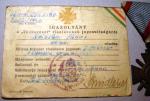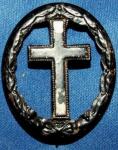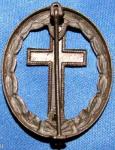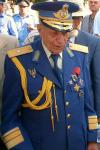-
Posts
9,099 -
Joined
-
Last visited
-
Days Won
4
Content Type
Profiles
Forums
Blogs
Gallery
Events
Store
Everything posted by Kev in Deva
-
Hallo Gentlemen, I offer this table medal for inspection, I obtained it about 4 years back from a dealer on British Ebay I think it set me back 10 GB Pounds at the time. I believe it has more of a Hungarian connection with regards where it originated, but stand open to correction. Description: the medal is 65mm in diameter, and consists of an inner core and outer-rim, the inner core is 49mm, and has on the front side a raised relief of Emperor Carol, to the left of the raised profile the Words .IV.KAROLY. in large letters, to the right side of the profile in small letters where the uniform meets the inner rim as the maker / designer name of:"KAUTSCM.H". The reverse inner core shows the Hungarian Crown in the center middle under this a sword with an orb and sceptre around the objects are laurel sprigs, behind the crown a river (the danube?) and on the far bank a city (Budapest?) at the top of the inner core the words "1916. DECEMBER.30. The outer rim is 7mm wide and 5mm thick and has a blue painted background with stylised oakleaves on the front side with the year 1917 at the six o'clock position and to the rear laurel leaves as its motif. On the rear where the to items join there are some slight traces of rust, which leads me to believe one of the componants are iron or steel and possibly the outer piece could be bronze. The table medal weighs 47gram. Feel free to post any comments, or show similar table medals. Kevin in Deva
-
Hallo Doc, be very careful about the non-sword varieties its not unknown for swords to be removed and then the cross sold on as the rare Civil award, particular attension has to be paid to the hole where the swords are fixed it should look like a tear-drop in shape and not round, also inspect for evidence of filing. Kevin in Deva-
-

Tips Appreciated
Kev in Deva replied to Tom Green's topic in Preservation & Restoration of Military Artifacts
Hallo Joe, thats a real nice display of Bavarian M. V. Kreuz One idea would be to place a piece of ribbon across the top or bottom of the display, under the glass as and example of the ribbon Do you have the late war model in zink?? Mine are displayed here, http://gmic.co.uk/index.php?showtopic=7352 Kevin in Deva -
Hallo Doc, nice one, sometimes the maker mark can be found on the rear of the sword blades. 3 Form 1913 - 1921 And the ribbon had two thin black stripes to denote a war-time award as opossed to the Blue & white peace-time ribbon. There also was a 4 Form 1916 - 1917 (came with a Crown & Swords, which just denotes a higher grade of III Class,) you can take a look at some other examples at http://gmic.co.uk/index.php?showtopic=7352 Kevin in Deva.
-
Hallo Tony, is there anything engraved on the shield device on the horses hoof?? hard to tell from the picture, could it have been given as a prize in a regimental sports-riding competion?? and can you post a better shot of the inside showing the clips? for ciggerettes or cigars?? (does it smell of tobbaco)? Kevin in Deva
-

Tips Appreciated
Kev in Deva replied to Tom Green's topic in Preservation & Restoration of Military Artifacts
Hallo Tom, Welcome to the club. As you look through the various threads and see pictures posted by members you will pick up some good ideas, with regards mounting, in the members collections section are some good examples, how ever this is restricted till you are given full membership, which is down to the number of posts you make. Cleaning is covered under a specific topic, and most members seem follow the old rule of not using any metal polish on medals to remove the patina, hard dust & grime I find, can be removed with an old tooth brush and for the non-iron containg medals & crosses a little soap and water, but keep the ribbons away from the water, and afterwards towl dry the excess water anduse a hair dryer to dry any nooks and crannys in crosses etc. I dust off my medal collection with a animal-hair paintbrush which is reserved specificaly for that job once a month. If you have any specific questions please feel free to post and dont be embarresed if it seems to be a silly question Kevin in Deva. -

Just a 1939-45 Star
Kev in Deva replied to deptfordboy's topic in Great Britain: Orders, Gallantry, Campaign Medals
Hallo Gilbert I think I would be peed off at the prospect of the war not ending for another 50 years Kevin in Deva -

Hungary Hungary - WW2 medals
Kev in Deva replied to Mossy's topic in Central & Eastern European States
-

Hungary Hungary - WW2 medals
Kev in Deva replied to Mossy's topic in Central & Eastern European States
Hallo hunyadi a beautiful decorative scroll, great artwork, the only piece of paper I have at the moment is for the Fire Cross, I have the cross itself but it is damaged, one sword tip being broken off Do you know was this small document issued with covers like a pay-book book? Kevin in Deva. -
Hallo David, thanks for the comment, which would fit in with "Apparently they were manufactured as Pilgrimage souviners at a Roman Catholic monastery near the Bodensee (Lake Constance) Bavaria, which at the end of World War II, found itself in possession of a store of 1939 black Wound Badges. The one on ebay is the first I have ever seen, with regards to the claim of it being originaly, an official award for a military chaplain, you have to wonder why they did not make an original die to stamp them out instead of this time consuming two piece fabrication from original wound badge items, obviously if they were converting original wound badges, officialy for the purpose stated, it would have been time saving to make a seperate die. Also the Prussian Military Wound badges that were fretted out were unofficial but tolarated versions, often when you see them being offered for sale the speil is they were only for officers Kevin in Deva.
-
Dear Gentlemen, WW1 MILITARY CHAPLAINS WOUND BADGE. this item is one I read about many moons ago in: WOUND MEDALS, INSIGNIA AND NEXT OF KIN AWARDS OF THE GREAT WAR. By Arthur H. Houston and Vicken Koundakjian. printed by O M S A Monograph 1995. Page. 93. The item was offered on Ebay at: http://cgi.ebay.com/ws/eBayISAPI.dll?ViewI...p;rd=1&rd=1 I also attach pictures taken from the site before they disapear. "Zabarylo (1988) alludes to a Wound Badge for the Chaplain Corps of the German Army. Said to have been authorised in March, 1918, it is described as comparable in dimensions to the Army Wound Badge, consisting of a laurel wreath enclosing a Cross. The badge is open (cut-out) with the Cross joined to the wreath vertically but not laterally. Only the black version is known. Although a number of collectors have confirmed the existence, the extensive documentation provided by the German Military Museum at Schloss Rastatt makes no referenc34 to this badge. Furthermore standard works in this field which provide more or less detailed information on the Army and Navy Wound Badges do not describe a Wound Badge presented soley to Chaplains (e.g., von Hessenthal and Schreiber 1940; Klietmann 1971 et seq.; Purves 1975; Mathis 1982). On the basis of his extensive study of German wound Badges, Hamelmann /1990b= found no evidence of its authorisation, and concluded that no such award was officially created. Apparently they were manufactured as Pilgrimage souvineers at a Roman Catholic monastery near the Bodensee (Lake Constance) Bavaria, which at the end of World War II, found itself in possession of a store of 1939 black Wound Badges. Hamelmann (1990b) notes that the market for these spurious "Chaplain Badges" proved to be good enough to warrent the casting of copies for sale! The latter are readily detectable as they are much heavier, i. e., approximately 19 as compared to 7 grams. As you can see from a close examination they are modified from a wound badge, and present an interesting if not totaly curious item of the fake trade for the true collector to ponder. Kevin in Deva
-

Regimental Names
Kev in Deva replied to Craig's topic in Great Britain: Research, Documentation & History
Hallo Marcus see: http://gmic.co.uk/index.php?showtopic=12026 just posted. Kevin in Deva -
In answer to this post on another thread: Replying to Regimental Names Hallo Marcus I believe this refers to a tragic incident during the 1916 Rebellion in Ireland, the Irish Republican Army (nothing to do with the terrorist bunch of today) were set in ambush in houses at a street intersection and caught the Sherwoods in a cross fire. * "Falling plates" were heavy steel targets about a foot square set upright on edge against the butts, and fired on in rifle competions the object to knock as many down as possible in the shortest time possible. Taken from: IN SOME FORGOTTEN FIELD By: John McGuiggan, Barrister at Law at: http://www.wfrmuseum.org.uk/rhr_Ireland.htm For a dead English (British) soldier of the Great War era it really doesn't matter whether the foreign field in which you finally rest is in Flanders or in Dublin. At least it shouldn't. But scattered across Dublin cemeteries lie the forgotten remains of the young men of the Sherwood Foresters Regiment who were slaughtered on Dublin's Streets during the 1916 Easter Rising. Their story, like their scruffy and neglected graves*, remains largely forgotten in the long and embarrassed history of the English in Ireland. They were volunteers, recruited from the towns and villages of Nottinghamshire. From Newark and Bingham from Huthwaite and Hucknall, Robin Hood county, the English folk hero from which the regiment took it's name. They had responded to Kitchener's posters, to fight in the trenches of Belgium and France, but had been caught instead in a smaller cause and had been pulled out of basic training at Watford to be thrown into street fighting against the Irish Rebels in Dublin. They were so raw. Most had less than three months of military service. They were unfamiliar with their weapons and had not yet had live firing practice. Young men with guns and little training are as much of a danger to themselves as they are to anyone else. On Dublin's dockside their officers issued live ammunition but ensured that as the men charged their weapons they were pointing their rifles safely out to sea - just in case of accidents amongst such unskilled soldiers. The officers, all volunteers from English public schools, breakfasted at St. George's harbourside Yacht club while the men opened tins of bully beef and biscuits. Some of the men thought they had landed in France. They were excited, keen, anxious and apprehensive.In the panelled rooms of the Yacht club the officers were briefed on the outbreak of Rebellion and given their orders. They were to divide their forces. Two of the battalions, Derbyshire men, would march round the city and enter from the west, making their way to Kilmainham hospital, now the Irish Museum of Modern Art, and thence to Dublin castle. They were to be heavily engaged in the rebellion but would suffer light causalities. Their most notable presence became known through the use of Guinness Company boilers mounted on the rear of lorries and deployed around the city centre as makeshift armoured cars. The other two battalions, the Nottinghamshire men, faced a much graver fate. They were to march straight though the heart of Dublin. Many of the raw young Robin Hoods would never make it. They would never see Belgium or France and never see again the forests of their native Sherwood.They marched towards their destiny armed only with Lee-Enfield rifles and bayonets. There was not a handgrenade between them. At Watford they had left with Lewis machine guns, two to each battalion. A fearsome, drum fed weapon, capable of firing .303 calibre bullets at a rate of upto 600 rounds per minute. But at Liverpool a zealous and bureaucratic loading officer insisted they leave the Lewis guns behind. It was to be a costly error. The Rebels towards which they now advanced were under the command of Eamon de Valera, the future Taoiseach and President of Ireland. They had been training for this moment for years. They were on home ground, better trained and more experienced than the oncoming Sherwood Foresters, well armed and superbly positioned in buildings heavily reinforced with sandbags and makeshift Barricades. Their task was to hold the Mount Street Canal Bridge and prevent troops entering the city centre to reinforce those already fighting around the General Post Office. They had to stop the oncoming Sherwood Foresters. At Clanwilliam house, directly opposite the bridge, De.Valera deployed some six men armed with a mix of Lee-Enfield's, German mausers and Italian Martini rifles. The house was a large gracious three story Georgian end terrace, with long elegant windows which gave commanding views over the approaches to the Mount Street bridge. More men were deployed in a school on the south corner of the bridge. And on the approach road to the bridge, at No. 25 Northumberland Road, behind barricaded and looped firing positions were deployed the experienced rebel volunteers Grace and Malone. They were to inflict the first and the heaviest of the Sherwood's casualties and the house, which still stands , bears a commemorative plaque to their efforts. In all some seventeen rebels held the chosen strongpoints around the Mount St. Bridge. The Mount Street canal bridge area is one of the most opulent of Dublin's suburbs. Graced by large substantial houses. It is the most sought after residential quarter of the city. But only for the rich for the houses are splendid and today you would pay more than two millon pounds for a semi-detached house of the kind in which Grace and Malone now awaited the raw unskilled soldiers of the Sherwood Foresters. They marched in the fine sunlight of a Dublin Spring. From Kingstown, where they landed (now known as Dun Laoghaire) though the wide tree lined streets towards the Canal bridge. Some harassing fire was directed at them as they neared the vicinity of the bridge but it was not of any great or determined effect. It was largely an enjoyable march, for the residents welcomed them and pressed tea and sandwiches upon the soldiers and offered gifts, including maps and field glasses. The battalion scouts riding ahead on bicycles were given detailed intelligence as to the Rebel positions towards which they now approached. Not all the intelligence was accurate. The Battalion adjutant Capt. Dietrichsen, a Nottingham barrister, was surprised and delighted to find his wife and children amongst those waving and welcoming the marching troops. She had left their native Nottingham, in fear of German Zeppelin raids, for the safety of Dublin. They embraced and hugged in the pure joy of the surprise. Captain Dietrichsen was amongst the first of the Robin Hoods to die. At the next corner, minutes after embracing his family, just 300 yards from the canal bridge, he, with the advance guard of the battalion, came under withering sustained fire from the rebels in 25 Northumberland Road. Ten Sherwood Foresters fell , amongst them Captain Dietrichsen and his colleague Lt. Hawken. The soldiers fell back onto the opposite side of the road not yet knowing from where the shots had come. They deployed along Northumberland Road in the spring sunshine, returning fire when they could. But streetfighting with rifles is an ineffective response to a well positioned urban enemy behind good and organised cover. What you need to get them out is light artillery, or tanks. The Lewis guns, left behind in Liverpool, would have kept the rebel heads down and reduced the now rapidly escalating casualties, but without a heavier and bettor weaponed response then it was always going to be wasteful slaughter. So it was to prove. Whatever these young raw Robin Hoods lacked in military experience and skills, they lacked nothing in bravery. No. 25 was identified as the source of their comrades sudden death and the remaining officers drew their swords and led the men in a ferocious bayonet charge across the road and towards the rebel's house. As they charged towards No. 25 they were caught in a merciless crossfire as the rebels in Clanwilliam house now opened fire. Terrible casualties were inflicted and soldiers fell all across Northumberland Road. From No. 25, Grace and Malone were firing point blank into the desperate ranks of the Robin Hoods, Grace emptying his Mauser pistol in an orgy of violence in the quiet and gracious suburb. Northumberland Road was wet with English Blood. The British infantry had been trained to advance towards enemy lines on the sound of a whistle. It was the only tactic they knew. Now, every twenty minutes or so, on the sound of a British Army issue whistle, the Robin Hoods again charged their enemy. They charged No. 25 Northumberland Road. They charged the school at the corner of the bridge. They charged the bridge. They charged Clanwilliam House. They charged and charged, and were slaughtered. They were refused permission to flank the rebels with an attack from the right. Only frontal attacks were to be allowed. The attacks were to be pressed home "at all costs". Frontal charges onto the guns of the rebels. By late in the day, when the Dublin Military Garrison provided them with a Lewis gun and with handgrenades, they had already lost some 230 men in dead and wounded. They lay all over the quiet suburb, along the grassy canal banks, by the bridge, around the school, the parochial hall, and across the steps of the grand houses. It was the handbombs and the machine gun that turned the battle. No 25 was finally overwhelmed with bombs, and one of the rebels shot, the other escaping. The school was taken but no rebels found, only the dead caretaker and his equally dead wife, the bridge was crossed, Clanwilliam house was bombed and burned and here, in the words of the regiments historian, at least three rebels met their death at the hands of the Robin Hoods, the other rebels getting clean away. From the perspective of the rebels this had been a magnificent victory. So many English dead at the hands of so few rebels. It was the Rorke's Drift of the Rebellion. Seventeen men had held off two battalions of the British Army. For the British it was a disaster. End of Article. * despite this remark, I, believe the graves are well tended by the British War Graves Commission. see : http://www.derbyshirelads.uwclub.net/Sherw...an_cemetery.htm http://www.derbyshirelads.uwclub.net/Sherw..._casualties.htm for a full casualty list. Kevin in Deva.
-

EK 1914 Non-magnetic 1813 EK2? Yea right.
Kev in Deva replied to Daniel Murphy's topic in Germany: All Eras: The Iron Cross
Hallo Gentlemen continuing tonights fun-filled entertainment I would like to post this link to tickle your fancy. . . . http://cgi.ebay.com/Iron-Cross-Unusual-Lik...1QQcmdZViewItem TAAA DA!! Kevin in Deva -

Luftwaffe Unknown pins
Kev in Deva replied to MichaW's topic in Wehrmacht Medals, Decorations & Awards
Hallo Mick, its a bad picture, but is the one on the left marked "J F" = Junge Frau ?? Kevin in Deva -

Hungary Hungary - WW2 medals
Kev in Deva replied to Mossy's topic in Central & Eastern European States
Hallo hunyadi, nice looking piece, I took the liberty of working on your picture to reduce the glare, hope you like the results, can you give an indication as to the size, and are there any variations between makers and years of manufacture? Kevin in Deva -
Hallo Dave. I have come across pictures of this WW2 vet (he was a fighter pilot) on another Romanian Forum, these shots from 2004, and again hard to tell if its an original, and it has been stated he wears the original WW2 EK which is surprising, seeing the swastika and iii reich items are banned from public display in Romania, no matter how much the supporters of the iron guard, whine about it. With regard the current medals being issued by the Romanians they are of a very poor quality and look a little similar to the old Royalist medals, but once in the hand they are like something you would give a child to play with, and in my opinion not very collactable. Kevin in Deva
-

My New WW2 Commonwealth Stars
Kev in Deva replied to Avitas's topic in Great Britain: Orders, Gallantry, Campaign Medals
Hallo Peter Have you never heard of the famous RAF Indian crewed, 666 Squadron, the Vindaloo Busters. Kevin in Deva. only joking guys -
Hallo Eduardo WW2 Italian can be posted at the: Axis Forces Militaria & History section listed at: Germany: Imperial Germany & Austria-Hungary, Weimar Republic, Third Reich, Post 1945, Militaria & History > Axis Forces Militaria & History on the main page Perhaps one of the Administration can be persuaded to re-locate your post there?? Kevin in Deva
-
Hallo Tom small point, wonder why he didnt turn over the bronze?? the silver looks ok, I would say the two clean looking ribbons are replacements, the hollow rivet in them looks to have a wider rim where the hook goes through. Kevin in Deva,











